Business Plan Sprouts - Doc PDF

| Title | Business Plan Sprouts - Doc |
|---|---|
| Author | Ya Mag |
| Course | Marketing |
| Institution | Pharos University in Alexandria |
| Pages | 72 |
| File Size | 4.9 MB |
| File Type | |
| Total Downloads | 73 |
| Total Views | 143 |
Summary
Doc...
Description
Sauder School of Business The University of British Columbia MBA Full-Time Program 2004
Project 2: Business Plan December 6, 2004
Team 22 Ruffo Diaz Jessica Lawson George Lee Mikio Matsuo Vivian Wang
TABLE OF CONTENT I. EXECUTIVE SUMMARY ......................................................................................................................................III II. THE INDUSTRY AND THE BUSINESS................................................................................................................1 A. B. C. D.
THE INDUSTRY ................................................................................................ 1 THE BUSINESS AND THE CONCEPT .......................................................................... 2 PRODUCTS .................................................................................................... 3 GROWTH STRATEGY.......................................................................................... 3
III. MARKET RESEARCH AND ANALYSIS .............................................................................................................4 A. B. C. D. E. F.
CUSTOMERS .................................................................................................. 4 SURVEY ANALYSIS............................................................................................ 4 MARKET SIZE AND TRENDS .................................................................................. 5 COMPETITION AND COMPETITIVE EDGES ...................................................................5 ESTIMATED MARKET SHARE AND SALES ....................................................................5 ONGOING MARKET EVALUATION ............................................................................. 5
IV. THE ECONOMICS OF THE BUSINESS ............................................................................................................6 A. B. C.
COMPONENTS OF GROSS MARGIN .......................................................................... 6 OPERATING COSTS ........................................................................................... 6 CASH FLOW AND PROFIT POTENTIAL ........................................................................ 6
V. MARKETING PLAN ............................................................................................................................................7 A. B. C. D. E.
PAST AND CURRENT MARKETING............................................................................ 7 MARKET SIZE AND TRENDS .................................................................................. 7 OVERALL MARKETING STRATEGY ........................................................................... 7 IMPLEMENTATION STRATEGY ................................................................................ 9 MARKETING SCHEDULE .................................................................................... 10
VI. OPERATING PLAN..........................................................................................................................................11 A. B. C. D. E. F. G.
OPERATING CYCLE .......................................................................................... 11 LOCATION ................................................................................................... 12 FACILITIES AND IMPROVEMENTS .......................................................................... 12 HUMAN RESOURCES ....................................................................................... 12 PROCUREMENT AND INVENTORY MANAGEMENT ......................................................... 13 TRANSPORTATION .......................................................................................... 13 COST AND QUALITY CONTROL ............................................................................. 14
VII. MASTER SCHEDULE....................................................................................................................................14 VIII. RISKS AND CONTINGENCIES .....................................................................................................................16 IX. THE FINANCIAL PLAN.....................................................................................................................................17 X. APPENDICES ....................................................................................................................................................19
ii
I. Executive Summary Sprouts is the full-time storefront of the UBC Natural Food Co-operative. It is located in the basement of the Student Union Building (SUB), the busiest building on campus. Food sold in the store is exclusively organic and fair trade. The store is student-run, and not-for-profit in the sense that making profits is secondary to its social purpose of promoting sustainable food systems. It has been trading since September 2004.
Services Sprouts offers customers an appealing selection of organic and fair trade food at reasonable prices. The store is attractively decorated and supported by friendly staff. Products in the store range from bulk ingredients to organic snacks and fresh produce from the UBC Farm. The store is unique in being the only specialist organic food store in the UBC campus area. Its location at the heart of the university is convenient for lunches and users of the nearby bus loop. Interest in organic food is strong and Sprouts looks set to benefit from market growth rates of nearly 20% per annum. Market The UBC campus has 7,000 residents, 42,000 students, and 11,000 faculty and staff. More than 8,000 people visit the SUB building each day. Since the store’s foundation membership of the UBC Natural Food Co-op has grown from 260 people to over 800. Although 80% of students responding our survey expressed an interest in organic food, over 40% of them were not yet aware of the store’s existence. The potential to grow sales through marketing is large. PROFITABILITY AND CASH FLOW As a student organization, Sprouts is tax-exempt and enjoys free rent and interest-free financing from the Alma Mater Society (AMS). Costs are further reduced by volunteers and inexpensive student labour. In its third month of operation Sprouts is poised to break even, and positive cash flow is less than four months ahead. If Sprouts
iii
can grow sales by 20% from November’s level, and increase gross margin by two percentage points, the store should be able to achieve a return on sales of 7% even after employing another part-time staff member.
Management Sprouts is managed by dedicated student workers, including some from the Sauder School of Business. Specific Recommendations Our analysis makes the following specific recommendations to Sprouts management: • There should be co-ordinated marketing campaigns every January and September, and continuing promotional activities throughout the year. • The store should boost profitability by selling more high-margin products such as bulk nuts and fruits. • Sprouts should bolster its snack food range and begin offering hot snacks such as organic soup. • The store should monitor inventory levels daily in order to introduce the News Vendor Model next year. • Sprouts should not attempt to grow its business by cutting prices. • In order to achieve financial security, Sprouts should aim to grow sales by 20% from November’s level and increase gross margin by 2 percentage points by May. It should then seek to maintain sales at this level in order to generate cash and not outgrow its premises.
iv
II. THE INDUSTRY AND THE BUSINESS A. THE INDUSTRY Since 1990 Canadians have become more conscious about health and the environment. Many have turned their attention to organic food. Although there is no direct evidence that organic food is better for health, many Canadians believe that organic products are better in taste, quality, and nutritional value. The term organic refers to agricultural products that are farmed in a socially responsible way. No chemicals (pesticides, fertilizers, antibiotics, or hormones) are used. A variety of herbs, grains, vegetables, fruits, and meats are produced organically but their production is usually more expensive owing to lower yields. Farmers must be certified by organizations such as the Canadian Organic Advisory Board. The Canadian organic food market grew by 19.4% in 2003 to reach a value of $928 million. The compound annual growth rate of the market in the period 1998-2003 was 18.7%, increasing from a low of 17.0% in 1999 to a high of 19.6% in 2002.
1
Exhibit 1 illustrates recent trends. The largest value segment is Meat,
accounting for 39.4% of the market, followed by Dairy, with 18.0%. Exhibit 2 illustrates segmentation. Canadian organic retail sales are expected to grow around 20 per cent a year to $3.1 billion in 2005. The industry aims to increase its share of total food sales (currently 1%) to 10% by 2010. 2 The organic food industry is competitive. Outlets can be grouped into three categories (see Exhibit 3): mass market outlets (49% of sales), health and natural food stores (48%), and farmers’ markets (3%).3 Stores compete mainly through differentiation. Each store where organic products are found each has a “personality” defined by its format, appearance, product variety, and relationship with customers. Organic products typically come with less packaging than non-organic products, have shorter shelf lives, and sometimes less visual appeal. This leads to high holding costs and intensifies competition for customers. There are no strong product brands at present. Consumers fall into three groups. Regular buyers (18% of all food consumers) consume organic products because they believe they are better for health and the environment. They are informed about organic farming
1
and fair trade, and are willing to pay higher prices for organic products if they are available. Occasional buyers (22% of all food consumers) are undecided about the benefits and more price-sensitive. They are likely to buy non-organic products if they are cheaper and more convenient. Occasional buyers have some information about organic and fair trade issues but might not completely understand the implications. The remainder of food consumers is not very interested and might not be aware of the existence of organic or fair trade products. British Columbians account for 13% of the Canadian population but 30% of organic food consumers.4 Fair trade refers to a system of distribution that ensures farmers get a fair price and encourages more egalitarian and sustainable production. International bodies such as TRANSFAIR and FLO offer certification to maintain standards. Fair trade products may or may not be organic. The organic food store industry is still in a high growth phase and barriers to entry are low. Exhibit 4 shows the five forces model of industry attractiveness. B. THE BUSINESS AND THE CONCEPT Sprouts is the full-time storefront of the UBC Natural Food Co-op. It sells a variety of organic and fair trade foods and groceries and is located on the lower level of the Student Union Building (SUB). The store is staffed and run by students and has been trading since September 2004. The aim of the business is to build sustainable food chains by promoting organic and fair trade food. Sprouts is “not for profit” in the sense that making profits is secondary to its social purpose. In addition to selling food, the store keeps a lending library of reading materials and has held numerous educational sessions about the benefits of organic and fair trade products. Educational activities will continue but will henceforth be funded directly by UBC Natural Food Co-op. The store’s fixtures and premises were built with support from the Alma Mater Society (AMS) and The UBC Campus Sustainability Office. As a venture of a student society, Spr outs is required to charge membership fees to people who shop there. Shoppers are charged $2 on their first purchase at the store, giving membership of the UBC Natural Food Co-op for one year.
2
The UBC Natural Food Co-op was founded in 1997 and is collectively owned and democratically controlled by its members, mainly people who study or work at the university. Membership was flat at around 60 members until 2003, when the co-operative started hosting Sustainability Networking Nights and building partnerships with the Dean of Agricultural Sciences, AMS, the Government of Canada, and Katimavik (a student exchange program). By late 2003 the co-operative was holding weekly markets in the SUB concourse and had 253 members. Since the foundation of Sprouts membership has grown to over 800 members. C. PRODUCTS Sprouts offers a variety of ecologically friendly products to fulfill numerous needs. Organically-grown and fairlytraded food products include fresh produce, fruit, baked goods, breads, dairy products, soy products, frozen food, bulk food, baking supplies, canned foods, chocolate, tea, coffee, and condiments. Non-food items include biodegradable cleaning and personal hygiene products. The product selection is outlined in Exhibit 5. D. GROWTH STRATEGY The UBC Natural Food Coop set some ambitious goals for the year 2005 assuming it would considerably increase its customer base with the opening of Sprouts. Its aspirations included:
1. Increase staff salaries from the current $10/hr to $15/hr, in-line with unionized jobs on campus, to provide adequate compensation to the store’s labor force and increase its motivation and encourage performance. 2. Reduce retail mark-up (currently at an average 33%) to the lowest possible in order to stimulate demand for organic and fair-trade foods. 3. Support the UBC Farm in scaling up production and developing a wider selection of produce. 4. Support rural communities in less industrialized countries, by establishing a Rural People Support Fund, and donating $1 of each UBC Food Co-op membership to a sustainable development project/rural community/co-operative in Latin America, Africa, or South-East Asia.
3
The above aspirations will have to wait until the store stabilizes operations. There are currently two main concerns. The first is that although management strongly believes there is a large potential market for organic products on campus, Sprouts has been slow in penetrating it. The second pertains to the sustainable operation of the store. The store enjoys a low cost structure because of its co-operative constitution and the favorable treatment it receives from AMS and others.
Management knows that without these benefits the store’s
continuance would be jeopardized. Attempting to grow the business too quickly by slashing prices would put pressure on cash flow and could cause destructive competition with AMS food outlets. We therefore propose that Sprouts should grow its business through marketing and improve margins through attention to product mix. The store is unlikely to be able to survive in a location where it has to pay rent, and so cannot outgrow its premises without more generosity from AMS. It should therefore aim to achieve profitability and sustainable positive cash flow by the end of the academic year, and maintain this level of operations in subsequent periods. III. MARKET RESEARCH AND ANALYSIS A. CUSTOMERS Our target customers are UBC students, staff and faculty who are interested in organic food by shopping at a small-scale, community-based Food Co-op store. B. SURVEY ANALYSIS
The market sample was carefully selected to cover a variety of the campus population. Refer to
Exhibit 11 for the criteria used for the survey.
Margins of errors E (for 95% confidence) = ± 7.76% (E =
1 n
, here n = 166)
Under this project’s conditions there was no choice but to use the available data. The survey is still on-going.
Approximately 80% of students are interested in organic food and 43% of these students who are interested in
4
organic food have never heard of “Sprouts”. The top three categories of interest are snacks, fresh produce and ingredients. See Exhibit 12. C. MARKET SIZE AND TRENDS There are 42,000 students in UBC. (There are 11,000 faculty and Staff which are not included in our survey). Based on the survey results, 80% or 33,600 students are somehow interested in organic food. The interest for organic food is growing and the market is constantly changing (students graduate and new students come in) D. COMPETITION AND COMPETITIVE EDGES
As a member of the AMS, Sprouts has to ensure it does not interfere with the other AMS businesses.
The SUB mainly offers a variety of fast food stores and coffee shops (Exhibit 6). Some outlets serve organic items however Sprouts has an advantage over them because they offer a wider variety of products. Organic stores off campus are a threat but “Sprouts” is located conveniently for students’ immediate needs and for those who live on campus.
E. ESTIMATED MARKET SHARE AND SALES
Based on the projected marketing campaign it is estimated that the annual sales growth will be 2% once the operations stabilize in September 2005. See Exhibit 14 for monthly sales growth for the current year and Exhibit 15 for that annual sales growth over the next three years.
The sales growth rate of each product category from September to October 2004 can be observed in Exhibit 15. The top four categories with the largest growth rates are farm food, fair trade, bulk food and Dairy. The
popular goods in Sprouts store are shelf foods, bulk food, fair trade and produce. F. ONGOING MARKET EVALUATION Thorough analysis of the sales data in addition to periodic surveys should allow the management team to assess the market trends. Furthermore, the sales people should ensure good communication and always get feedbacks from the customers in store. 5
IV. THE ECONOMICS OF THE BUSINESS A. COMPONENTS OF GROSS MARGIN Exhibit 7 shows our calculation of the components of gross margin, which is based on unit costs and October’s till record. Sprouts also has an “open” till category for special and discounted items. Gross profit from this category is assumed to be zero, except in the case of farm produce, where the store’s estimate is used. We draw no distinction between gross margin and contribution margin because the only variable cost omitted is small (Ziploc bags and labels), and because the store’s size means that inventory levels cannot change quickly. Mark-ups by product category range from 6% (vegetables) to 72% (pasta), with an overall level around 33%, implying a gross margin of 25%. Cakes and wraps, and the nuts, seeds, and fruits category, were the two largest gross profit contributors. Snacks and convenience foods as a whole provide around half of gross profits. B. OPERATING COSTS All other costs are fixed for current staffing levels and a given number of opening hours, and total around $2,800 for a full 20-day month. Profitable operation would not be possible without assistance from the Katimavik intern (worth around $1,700 per month), voluntary work from students, and free rent, although the store could soon afford another paid part-timer. As part of a student society, Sprouts can also fund equipment and inventory interest free through its AMS credit line, and is exempt from taxes. Thanks to the above special advantages, the store is already close to breaking even and will likely turn a profit for November, despite some equipment failures. On our estimated gross margin for November’s sales mix (26%), we estimate breakeven sales at $10,700 (see Exhibit 8), and at $12,000 on a 27% gross margin if a parttime worker is added at $450 per month in the spring. C. CASH FLOW AND PROFIT POTENTIAL Sprouts is likely to start producing positive net cash...
Similar Free PDFs

Business Plan Sprouts - Doc
- 72 Pages

Business plan template doc
- 20 Pages
![UBER Business Plan [doc]](https://pdfedu.com/img/crop/172x258/gm3nl51e52n7.jpg)
UBER Business Plan [doc]
- 13 Pages

CUE- Business-PLAN - Business plan
- 10 Pages

Business-Plan - Business plan Enc
- 48 Pages

Nursing Care Plan Doc
- 17 Pages
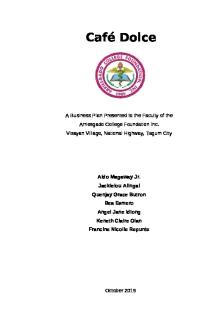
Business Plan
- 26 Pages

Business PLAN
- 3 Pages
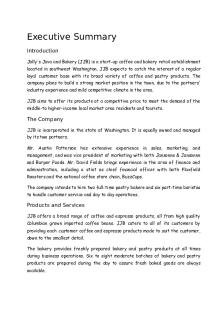
Business PLAN
- 21 Pages
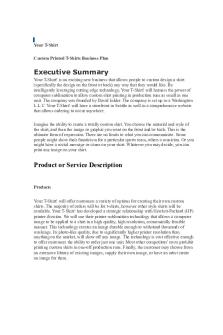
Business PLAN
- 10 Pages

BUSINESS PLAN
- 24 Pages
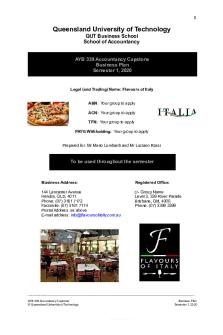
Business Plan
- 28 Pages

Business Plan
- 21 Pages
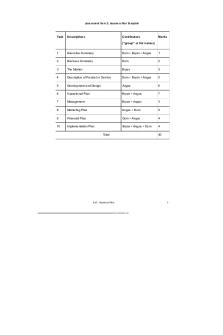
Business plan
- 40 Pages
Popular Institutions
- Tinajero National High School - Annex
- Politeknik Caltex Riau
- Yokohama City University
- SGT University
- University of Al-Qadisiyah
- Divine Word College of Vigan
- Techniek College Rotterdam
- Universidade de Santiago
- Universiti Teknologi MARA Cawangan Johor Kampus Pasir Gudang
- Poltekkes Kemenkes Yogyakarta
- Baguio City National High School
- Colegio san marcos
- preparatoria uno
- Centro de Bachillerato Tecnológico Industrial y de Servicios No. 107
- Dalian Maritime University
- Quang Trung Secondary School
- Colegio Tecnológico en Informática
- Corporación Regional de Educación Superior
- Grupo CEDVA
- Dar Al Uloom University
- Centro de Estudios Preuniversitarios de la Universidad Nacional de Ingeniería
- 上智大学
- Aakash International School, Nuna Majara
- San Felipe Neri Catholic School
- Kang Chiao International School - New Taipei City
- Misamis Occidental National High School
- Institución Educativa Escuela Normal Juan Ladrilleros
- Kolehiyo ng Pantukan
- Batanes State College
- Instituto Continental
- Sekolah Menengah Kejuruan Kesehatan Kaltara (Tarakan)
- Colegio de La Inmaculada Concepcion - Cebu

